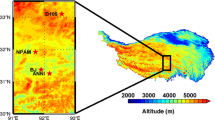Abstract
This paper presents a simple method for reconstructing daily catchment-wide evapotranspiration (ET) where only two kinds of daily data are available, i.e., catchment-wide precipitation and streamflow at the outlet. Here, multi-annual ET of a catchment obtained from water budget is decomposed into daily values considering two daily factors of insolation at the top of atmosphere (r factor) and precipitation presence (h factor). Precipitation presence is adopted as a surrogate of humidity which is related to two effects of (1) atmospheric transmittance of insolation and (2) moisture diffusion near surface. It is hypothesized that daily humidity condition is described with precipitation presence of the day, the previous day, and the following day. On the basis of this idea, eight possible scenarios are proposed for humidity condition. This paper reports h values analyzed from long-term data of observed pan evaporation and precipitation for five stations in Korea. h values show significant difference between eight scenarios, implying that the proposed scheme is effective in distinguishing various atmospheric conditions in a simple manner. There exists a varying degree of seasonal and spatial variability in h. Such variability is geo-physiographically explained through analysis of other meteorological data such as relative humidity, cloud cover, sunshine duration, surface solar radiation, and wind speed. The proposed methodology is applied for reconstructing daily ET of a real catchment in Korea. Calculated daily ET values well agree with observed pan evaporation data. The proposed method is also well compared with the Priestley–Taylor method, where the latter requires daily air temperature. The proposed method successfully captures sudden daily ET fluctuations in accordance with precipitation presence which is hardly captured by the Priestley–Taylor method. Further, the reconstructed data nicely follow the trend of LandFlux-EVAL dataset.













Similar content being viewed by others
References
Brutsaert W (1982) Evaporation into the atmosphere. D. Reidel Publishing Company, Dordrecht
Brutsaert W (2005) Hydrology: an introduction. Cambridge University Press, Cambridge, p 605
Camporese M, Daly E, Dresel PE, Webb JA (2014) Simplified modeling of catchment-scale evapotranspiration via boundary condition switching. Adv Water Resour 69:95–105. doi:10.1016/j.advwatres.2014.04.008
Dingman SL (2002) Physical hydrology. Waveland Press, Long Grove, p 646
Evett SR, Kustas WP, Gowda PH, Anderson MC, Prueger JH, Howell TA (2012) Overview of the bushland evapotranspiration and agricultural remote sensing experiment 2008 (BEAREX08): a field experiment evaluating methods for quantifying ET at multiple scales. Adv Water Resour 50:4–19. doi:10.1016/j.advwatres.2012.03.010
Liou KN (2002) An introduction to atmospheric radiation, 2nd edn. Academic Press, Cambridge, p 583
McGrath GS, Sadler R, Fleming K, Tregoning P, Hinz C, Veneklaas EJ (2012) Tropical cyclones and the ecohydrology of Australia’s recent continental-scale drought. Geophys Res Lett 39:L03404. doi:10.1029/2011GL050263
Mueller B, Hirschi M, Jimenez C, Ciais P, Dirmeyer PA, Dolman AJ, Fisher JB, Jung M, Ludwig F, Maignan F, Miralles D, McCabe MF, Reichstein M, Sheffield J, Wang KC, Wood EF, Zhang Y, Seneviratne SI (2013) Benchmark products for land evapotranspiration: LandFlux-EVAL multi-dataset synthesis. Hydrol Earth Syst Sci 17:3707–3720. doi:10.5194/hess-17-3707-2013
Oke TR (1987) Boundary layer climates, 2nd edn. Routledge, Abingdon-on-Thames, p 435
Paik K, Kim HS, Lee DR, Kim JH (2001) Estimation of daily evapotranspiration based on water budget method. In: Proceedings of the Korea Water Resources Association Conference, held in Daegu Korea, May 12, pp 483–488
Paik K, Kim JH, Kim HS, Lee DR (2005) A conceptual rainfall-runoff model considering seasonal variation. Hydrol Process 19:3837–3850. doi:10.1002/hyp.5984
Priestley CHB, Taylor RJ (1972) On the assessment of surface heat flux and evaporation using large-scale parameters. Mon Weather Rev 100(2):81–92
Rohwer C (1931) Evaporation from free water surfaces. US Dept Agric Tech Bull 271:96
Seol A, Lee B, Chung J (2012) Analysis of the seasonal characteristics of forest fires in South Korea using the multivariate analysis approach. J For Res 17(1):45–50. doi:10.1007/s10310-011-0263-8
Sivapalan M, Yaeger MA, Harman CJ, Xu X, Troch PA (2011) Functional model of water balance variability at the catchment scale: 1. Evidence of hydrologic similarity and space–time symmetry. Water Resour Res 47(2):W02522. doi:10.1029/2010WR009568
Struthers I, Hinz C, Sivapalan M (2007) Conceptual examination of climate–soil controls upon rainfall partitioning in an open-fractured soil II: response to a population of storms. Adv Water Resour 30:518–527. doi:10.1016/j.advwatres.2006.04.005
Tanner CB, Thurtell GW (1969) Anemoclinometer measurements of Reynolds stress and heat transport in the atmospheric surface layer, ECOM 66-G22-F, ECOM, United States Army Electronics Command, Research and Development. US Army Electronics Command. Atmospheric Sciences Laboratory, Fort Huachuca
Xu C-Y, Singh VP (2002) Cross comparison of empirical equations for calculating potential evapotranspiration with data from Switzerland. Water Resour Manag 16:197–219
Acknowledgments
This research was supported by the Basic Science Research Program through the National Research Foundation of Korea (NRF) funded by the Ministry of Science, ICT and Future Planning (Grant number 2015R1A2A2A05001592). Daily runoff at the Daecheong dam site is obtained from the Ministry of Land, Infrastructure, and Transport. Ground-observed meteorological data used in this study are obtained from the Korean Meteorological Administration (http://www.kma.go.kr/weather/climate/past_cal.jsp). This study uses the LandFlux-EVAL merged benchmark synthesis products of ETH Zurich produced under the aegis of the GEWEX and ILEAPS projects (http://www.iac.ethz.ch/url/research/LandFlux-EVAL/). I thank Gavan S. McGrath for encouragement and helpful discussions in finalizing the manuscript.
Author information
Authors and Affiliations
Corresponding author
Appendix
Appendix
See Table 5.
Rights and permissions
About this article
Cite this article
Paik, K. Reconstructing daily evapotranspiration data from multi-annual water budget using insolation and precipitation presence. Environ Earth Sci 75, 1010 (2016). https://doi.org/10.1007/s12665-016-5801-4
Received:
Accepted:
Published:
DOI: https://doi.org/10.1007/s12665-016-5801-4




